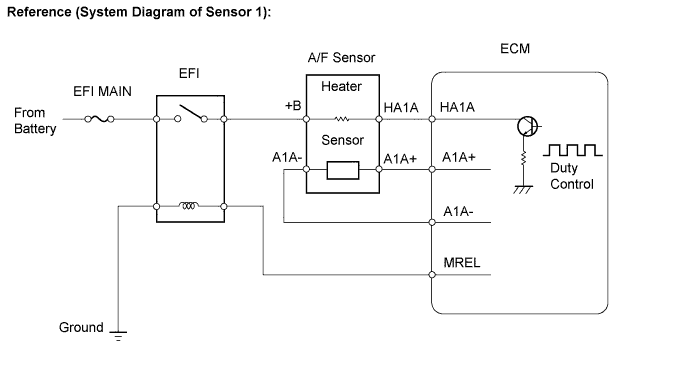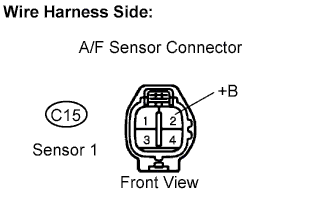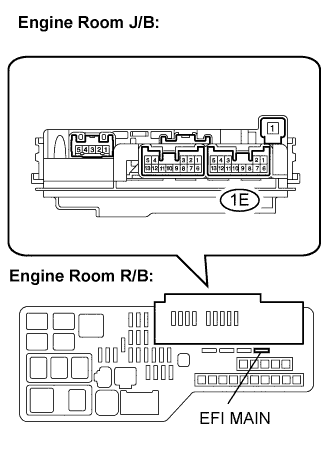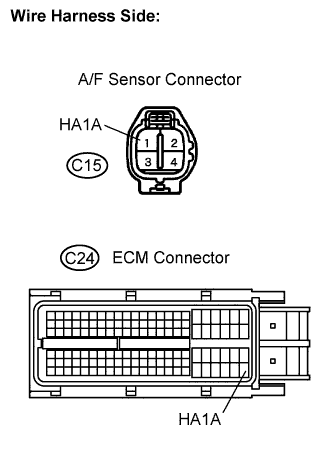INSPECT AIR-FUEL RATIO SENSOR (HEATER RESISTANCE)
CHECK TERMINAL VOLTAGE (+B OF A/F SENSOR)
INSPECT ENGINE ROOM J/B (EFI RELAY, EFI MAIN FUSE)
CHECK HARNESS AND CONNECTOR (A/F SENSOR - EFI RELAY)
CHECK HARNESS AND CONNECTOR (A/F SENSOR - ECM)
CHECK WHETHER DTC OUTPUT RECURS
DTC P0031 Oxygen (A/F) Sensor Heater Control Circuit Low (Bank 1 Sensor 1) |
DTC P0032 Oxygen (A/F) Sensor Heater Control Circuit High (Bank 1 Sensor 1) |
DESCRIPTION
Refer to DTC P2195 (Link).- HINT:
- Although the DTC titles say oxygen sensor, these DTCs relate to the Air-Fuel Ratio (A/F) sensor.
- Sensor 1 refers to the sensor mounted in front of the Three-Way Catalytic Converter (TWC) and located near the engine assembly.
- When either of these DTCs is set, the ECM enters fail-safe mode. The ECM turns off the A/F sensor heater in fail-safe mode. Fail-safe mode continues until the ignition switch is turned off.
- The ECM provides a pulse width modulated signal to the control circuit to adjust the current through the heater. The A/F sensor heater circuit uses a relay on the +B side of the circuit.

| DTC No. | DTC Detection Condition | Trouble Area |
| P0031 | Air-Fuel Ratio (A/F) sensor heater current less than 0.8 A (1 trip detection logic) |
|
| P0032 | Air-Fuel Ratio (A/F) sensor heater current more than 10 A (1 trip detection logic) |
|
MONITOR DESCRIPTION
The ECM uses information from the Air-Fuel Ratio (A/F) sensor to regulate the air-fuel ratio and keep it close to the stoichiometric level. This maximizes the ability of the Three-Way Catalytic Converter (TWC) to purify the exhaust gases.The A/F sensor detects oxygen levels in the exhaust gas and transmits the information to the ECM. The inner surface of the sensor element is exposed to the outside air. The outer surface of the sensor element is exposed to the exhaust gas. The sensor element is made of platinum coated zirconia and includes an integrated heating element.
The zirconia element generates a small voltage when there is a large difference in the oxygen concentrations between the exhaust gas and outside air. The platinum coating amplifies this voltage generation.
The A/F sensor is more efficient when heated. When the exhaust gas temperature is low, the sensor cannot generate useful voltage signals without supplementary heating. The ECM regulates the supplementary heating using a duty-cycle approach to adjust the average current in the sensor heater element. If the heater current is outside the normal range, the signal transmitted by the A/F sensor becomes inaccurate, as a result, the ECM is unable to regulate air-fuel ratio properly.
When the current in the A/F sensor heater is outside the normal operating range, the ECM interprets this as a malfunction in the sensor heater and sets a DTC.
Example:
The ECM sets DTC P0032 when the current in the A/F sensor heater is more than 10 A. Conversely, when the heater current is less than 0.8 A, DTC P0031 is set.
WIRING DIAGRAM
Refer to DTC P2195 (CAMRY_ACV40 RM000000WC401HX_07.html).INSPECTION PROCEDURE
- HINT:
- Read freeze frame data using the intelligent tester. The ECM records vehicle and driving condition information as freeze frame data the moment a DTC is stored. When troubleshooting, freeze frame data can help determine if the vehicle was moving or stationary, if the engine was warmed up or not, if the air-fuel ratio was lean or rich, and other data from the time the malfunction occurred.
| 1.INSPECT AIR-FUEL RATIO SENSOR (HEATER RESISTANCE) |
Disconnect the C15 A/F sensor connector.
 |
Measure the resistance between the terminals of the A/F sensor connector.
- Standard resistance:
Tester Connection Specified Condition HA1A (1) - +B (2) 1.8 to 3.4 Ω at 20°C (68°F) HA1A (1) - A1A- (4) 10 kΩ or higher
Reconnect the A/F sensor connector.
|
| ||||
| OK | |
| 2.CHECK TERMINAL VOLTAGE (+B OF A/F SENSOR) |
Disconnect the C15 A/F sensor connector.
 |
Turn the ignition switch to the ON position.
Measure the voltage between the terminal of the A/F sensor connector and body ground.
- Standard voltage:
Tester Connection Specified Condition +B (C15-2) - Body ground 9 to 14 V
Reconnect the A/F sensor connector.
|
| ||||
| NG | |
| 3.INSPECT ENGINE ROOM J/B (EFI RELAY, EFI MAIN FUSE) |
Inspect the EFI MAIN fuse.
Remove the EFI MAIN fuse from the engine room J/B.
Measure the EFI MAIN fuse resistance.
- Standard resistance:
- Below 1 Ω
Reinstall the EFI MAIN fuse.
 |
Inspect the EFI relay.
Remove the engine room J/B from the engine room R/B.
Measure the EFI relay resistance.
- Standard resistance:
Tester Connection Specified Condition 1E-7 - 1E-12 10 kΩ or higher Below 1 Ω
(Apply battery voltage between terminals 1E-9 and 1E-11)
Reinstall the engine room J/B.
|
| ||||
| OK | |
| 4.CHECK HARNESS AND CONNECTOR (A/F SENSOR - EFI RELAY) |
Disconnect the C15 A/F sensor connector.
 |
Remove the engine room J/B from the engine room R/B.
Disconnect the 1E engine room J/B connector.
Measure the resistance between the terminals.
- Standard resistance (Check for open):
Tester Connection Specified Condition +B (C15-2) - Engine room J/B (1E-7) Below 1 Ω
- Standard resistance (Check for short):
Tester Connection Specified Condition +B (C15-2) or Engine room J/B (1E-7) - Body ground 10 kΩ or higher
Reconnect the A/F sensor connector.
Reconnect the engine room J/B connector.
Reinstall the engine room J/B.
|
| ||||
| OK | ||
| ||
| 5.CHECK HARNESS AND CONNECTOR (A/F SENSOR - ECM) |
Disconnect the C15 A/F sensor connector.
 |
Disconnect the C24 ECM connector.
Measure the resistance between the terminals of the wire harness side connectors.
- Standard resistance (Check for open):
Tester Connection Specified Condition HA1A (C15-1) - HA1A (C24-109) Below 1 Ω
- Standard resistance (Check for short):
Tester Connection Specified Condition HA1A (C15-1) or HA1A (C24-109) - Body ground 10 kΩ or higher
Reconnect the A/F sensor connector.
Reconnect the ECM connector.
|
| ||||
| OK | |
| 6.CHECK WHETHER DTC OUTPUT RECURS |
Connect the intelligent tester to the DLC3.
Turn the ignition switch to the ON position.
Turn the tester on.
Clear the DTCs (CAMRY_ACV40 RM000000PDK01RX.html).
Start the engine.
Allow the engine to idle for 1 minute or more.
Select the following menu items: Powertrain / Engine and ECT / DTC.
Read the DTCs.
- Result:
Display (DTC Output) Proceed to No output A P0031 or P0032 B
|
| ||||
| A | ||
| ||